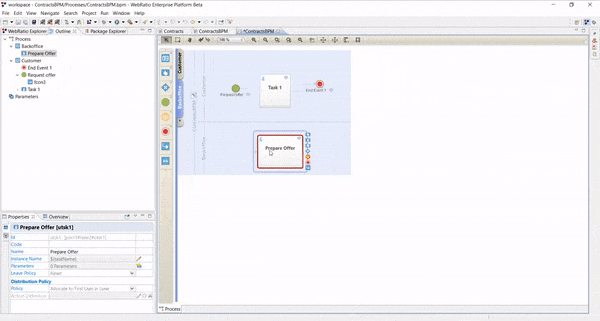Process Governance: The Quality Leap with BPM and Low-Code

Business process governance manages the alignment of various activities with the needs of both internal and external stakeholders. It concerns the processes and decisions aimed at verifying performance, defining actions, and assigning ownership[1].
Proper governance is essential to understanding, standardizing, and knowing how to improve value creation within the enterprise and how this value is delivered to customers.
The fundamental difference between governance and process management is that the former guides the latter toward business goals, ensuring consistency. However, governance without business process management couldn't implement any actions, nor would it have the crucial information needed to understand process performance and decide on corrective measures.
Accurate information is an asset that governance cannot do without, and thanks to the digitalization of office, factory, and construction site activities, it is now possible to track data in detailed, simple, secure, and reliable manner, from which the necessary information can be extracted to understand activity performance
Among the principles[2] of proper process management, modeling is fundamental as it allows for the design, definition, and selection of the necessary resources to gain a deep and shared understanding of business processes.
This is where Low-Code tools like WebRatio Platform come into play, as they integrate visual systems for the design, management, and implementation of digital processes.

Tools like the Business Process Designer are useful for process modeling in visual, clear, and standardized way (using BPMN 2.0 notation). Digital models become the necessary documentation for understanding roles and activities, but not only that: when BPM systems are integrated into Low-Code platforms like WebRatio Platform, the process models guide the execution of activities carried out through web and mobile applications.
With this process-based development approach, it is possible to track essential data and extract the necessary information for proper governance.
-
What activities require the most time?
-
Which of these are digital and automatic?
-
What activities are most requested by customers?
-
Which ones do they spend the most time on?
-
Can the online experience be improved?
-
Can further automation be achieved through technologies like RPA and AI?
These are just a few examples of questions that can be answered more easily with process management-driven application development.
Governance can therefore be simplified and made more secure because it is based on information with a degree of certainty that would be impossible to achieve without BPM systems.
However, the certainty of information is not the only advantage of platforms like WebRatio.
The components of process governance are six[3] ,and for each one, a quality leap can be traced thanks to Low-Code platforms.
|
Key Components of Process Governance |
Advantage of BPM in WebRatio Platform |
|
High-level identification of the main cross-enterprise business processes |
BPMN modeling also allows the creation of subprocesses. Macro, general, and cross-enterprise processes can be created that contain subprocesses defined at the division or business function level. |
|
Clarity on objectives to define key performance indicators (KPIs) for these processes |
Data tracking allows for more certain and detailed monitoring of KPIs, even dividing them by business area, division, or role. |
|
Responsibility and ownership for managing business processes, combined with appropriate power, control, and guidelines |
Modeling allows for a clear definition of roles, responsibilities, and access privileges, making it easier to apply guidelines. |
|
Knowledge management of processes to achieve the necessary transparency that enables quick, well-informed decisions and related actions |
Transparency is guaranteed by the BPMN model that describes the execution flow in a standard and shareable way with everyone, avoiding interpretation problems. Tracking the performance of activities and the data processed allows for better knowledge management of the processes. |
|
Aligned recognition and reward systems |
The security of collected data is reflected in the certainty of achieving recognized KPIs. |
|
Prioritization based on organizational goals |
The comprehensive view of processes, activities, and business objectives makes it easier to know which priorities to focus on. Process orchestration allows for the allocation of activities based on defined business rules. |
Not Just Process Control, But Also Risk Prevention
BPMN modeling is not only useful for controlling and verifying the correctness of processes but also for activities such as identifying potential risks[4].
Here are some examples of activities supported by technology:
|
Risk Identification |
By designing the flow of information and systems, it is possible to see critical points where weaknesses could be susceptible to cyber threats. |
|
Security Control Mapping |
By inserting controls within the model, security measures can be ensured to mitigate risks and comply with regulations. |
|
Incident Response Planning |
By mapping the steps and decision points involved in incident management, coordination, and communication between stakeholders can be improved during critical situations. |
|
Compliance and Audit |
BPMN diagrams help demonstrate compliance with regulations and standards. By mapping processes and controls according to relevant requirements, auditors are provided with a clear view of the organization's approach to cybersecurity and data protection. |
Low-Code platforms like WebRatio Platform, which integrate BPM systems, offer benefits to the entire company, starting with governance. They enable a quality leap by simplifying the design and structuring of processes, providing more precise analysis and control, and more accurately identifying and preventing risks. All these benefits help directors to align activities more reliably with the company's needs and goals.
Request a WebRatio Platform demo >
Sources
[4] https://www.linkedin.com/pulse/7-tips-mastering-cyber-governance-bpmn-visualize-secure/
Latest Stories
CIO priority for 2026: boosting productivity, including Low-Code
Customised AI in 1 Month with Low-Code: AI Mind by OriginalSkills
WebRatio Platform 9.3.0: more autonomy, more productivity, more control – and a new look for your apps
Tag
AllArtificial Intelligence - AI
BPA Development
BPM Software
Customer
Digital Transformation
Distribution & Retail
Energy & Utilities
Enterprise Applications
Finance & Insurance
IoT
LinkedIn Live
Low-code
Manufacturing
Mobile Development
Modernization
Partner
Shadow IT
Travel & Transportation
Web Development
WebRatio Platform